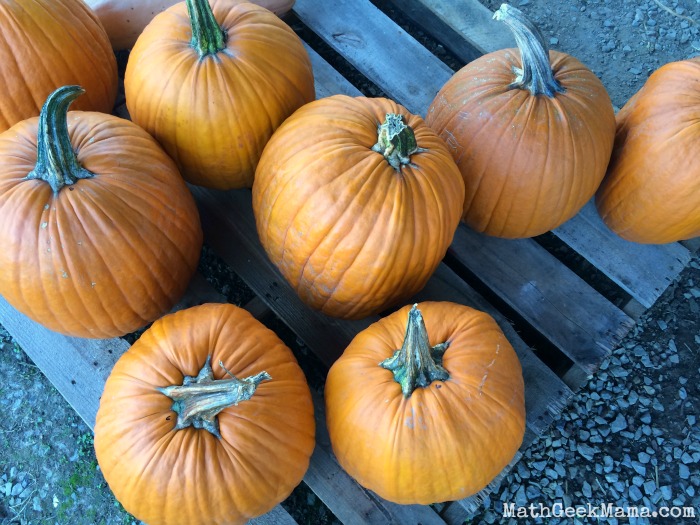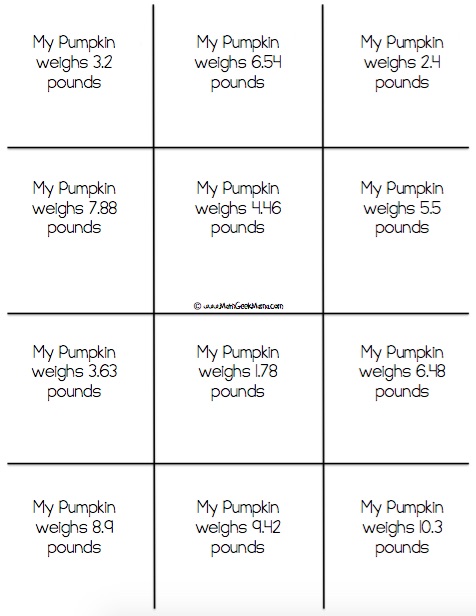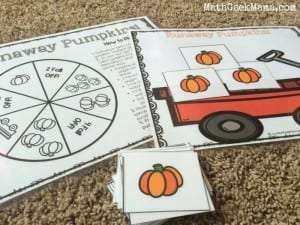How Much Does a Pumpkin Cost? {FREE Algebra Lesson!}
For many students, the transition from math computations in the upper elementary grades to Algebra is a challenge. Suddenly, they are having to write mathematical equations and use symbols and letters rather than just numbers. (Although hopefully they have at least been introduced to some of these things prior to formal Algebra). One way to help students ease the transition and make sense of it all is by looking at real and meaningful examples. Today I’m going to share a 3 part Algebra lesson based on finding the cost of a pumpkin!

*Please Note: This post contains affiliate links which help support the work of this site. Read our full disclosure here.*
I recently took my kids to the pumpkin patch to pick out a variety of pumpkins because it’s a really fun Fall activity, but also because there are so many learning activities you can do! But picking out pumpkins isn’t just fun for elementary students! 😉

Materials Needed For Finding the Cost of a Pumpkin Lesson:
- Variety of pumpkins (or data cards included in the download)
- A scale
to measure the weights
- Student lesson handouts (3 pages)
Teaching and Exploring with this Pumpkin Lesson:
Ideally, you want to have a variety of real pumpkins. If you are a classroom teacher, you could have each student that’s able bring one from home, or you could let your colleagues know and see if a handful of teachers can each bring one pumpkin.
You don’t need tons, 6-8 would probably be sufficient. Just make sure they are a good variety of sizes from very small to relatively large.

Once you’ve gathered your materials, you can begin the first lesson. Here’s basic outline of the lessons:
- Writing an equation for the cost and then evaluating that equation using the different weights of pumpkins.
- Writing different equations for the cost given certain restraints, and then re-evaluating for the costs.
- Given an equation for the total cost, determine the largest pumpkin that can be purchased given a certain amount of money (solving linear equations).
Each lesson builds on the last, and while you do not need to do all three lessons in one day, you do need to keep the data and lesson pages together so students can refer back to the weights and equations they have used.
While I think this will work best and be the most fun if you have actual pumpkins to weigh and consider, (maybe you could even go to a farm to do this!), I know this is not going to be possible for everyone. Whether you don’t have time to gather materials, or don’t have time to weigh all the pumpkins, I understand that it might not be feasible.
To help you, I’ve also included in this lesson 24 data cards that you can cut out and hand out to students telling them the weight of their imaginary pumpkin. They can then share their data with their group or classmates and complete the lessons that way.

Included in Finding the Cost of a Pumpkin lesson packet:
- Teaching tips and directions
- Student handouts
- Answer keys
- 24 data cards with pumpkin weights

{Click HERE to go to my shop to download the “How Much Does A Pumpkin Cost” Algebra Lesson!}
*Psst! Guess what? This 3 part lesson is included in my HUGE Algebra Essentials Resource Bundle! Everything you need to teach in a way that makes sense and build a solid foundation for students! Click the graphic below to learn more!
Have younger ones who want to join the pumpkin math fun? Grab this FREE “Runaway Pumpkins” board Game!














This is such a great lesson idea! I think I’ll adapt it for my younger kids and introduce units of measure. Thanks so much! 🙂
Oh thanks! Yes, you could definitely adapt it and get younger kids measuring and starting to think algebraically! 🙂 Popping over to visit your site now!
Great lesson! I always appreciate math that uses real world examples, so students can see that math is more than just a subject in school, it’s actually an important skill for everyday life.